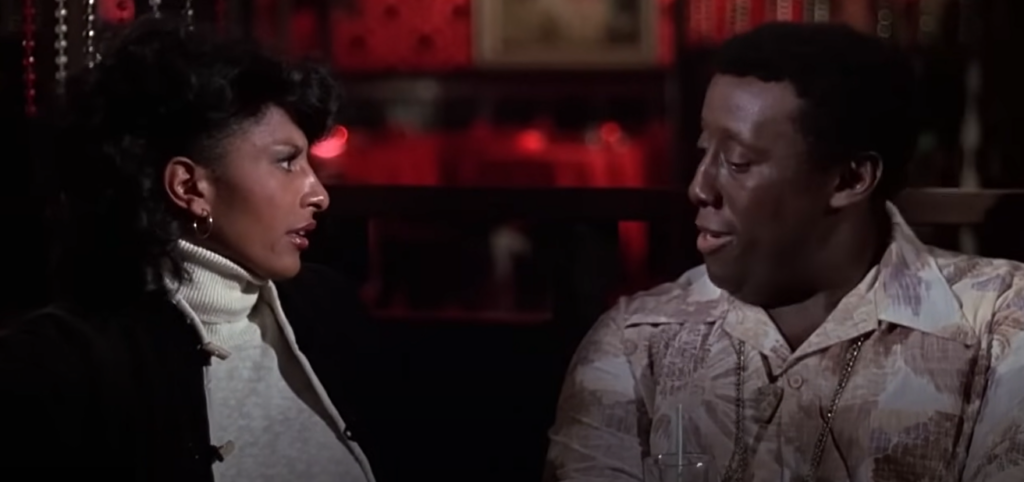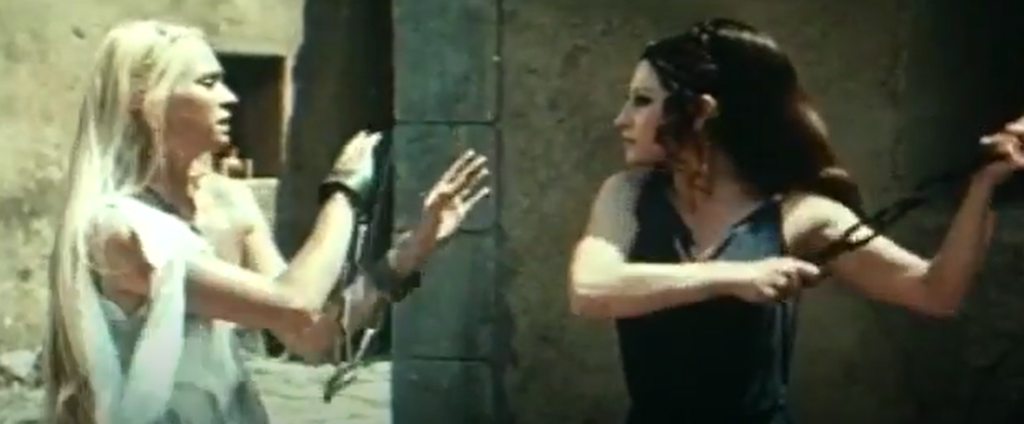Pam Grier, born Pamela Suzette Grier on May 26, 1949, began her cinematic journey in the 1970s. These were transformative years for the film industry, as societal shifts echoed within the narrative landscape. Among these transformations, the emergence of Blaxploitation films was particularly significant. Grier found her niche in this genre, becoming a symbol of strength, resilience, and female empowerment.
The Initial Breakthrough: A Deeper Look
Grier’s entry into the realm of acting was not through auditions or acting schools, but rather a chance encounter. She was working at the switchboard at American International Pictures (AIP) when she was noticed by director Jack Hill. Her stunning looks and the natural charisma she exhibited even in this ordinary job scenario caught Hill’s attention, and her film career was born.
‘The Big Doll House’ (1971)
Grier’s cinematic breakthrough arrived with Jack Hill’s ‘The Big Doll House’ in 1971. In this women-in-prison film, she played the character of Grear, a tough inmate in a jungle prison. Despite it not being a lead role, Grier’s performance stood out, making an indelible impression on audiences and industry members alike.
‘The Big Doll House’ pushed boundaries with its explicit content and realistic portrayal of prison life, including the raw human emotions that dominate such settings. The film was an unexpected commercial success, providing Grier with the leverage she needed to launch her film career.
‘The Big Bird Cage’ (1972)
‘The Big Bird Cage’, directed by Jack Hill, was another women-in-prison film that allowed Grier to continue showcasing her acting abilities. In this film, she played Blossom, a fiery character who, along with her boyfriend, stages a prison break. Once again, Grier’s performance stood out, solidifying her position as an actress capable of handling gritty, action-packed roles.
‘Coffy’ (1973)
‘Coffy’, another Jack Hill classic, provided Grier with her first leading role. She starred as Coffin (Coffy) O’Brien, a nurse on a quest for revenge against the drug dealers who got her younger sister addicted to drugs. Grier’s compelling performance as an assertive, justice-seeking woman, along with the film’s successful blend of action and drama, turned ‘Coffy’ into a commercial hit. The film is often noted as a quintessential Blaxploitation film, primarily due to Grier’s powerful portrayal of a Black woman who takes justice into her own hands.
‘Foxy Brown’ (1974)
Grier once again collaborated with Jack Hill in ‘Foxy Brown’, playing the eponymous role of Foxy, a woman seeking vengeance against a drug syndicate for her boyfriend’s assassination. The character of Foxy Brown is considered one of the most iconic roles in Blaxploitation cinema. Grier brought a combination of charm, assertiveness, and fearlessness to the character, making Foxy Brown a household name.
‘Sheba, Baby’ (1975)
Grier’s role in ‘Sheba, Baby’ added another facet to her ever-expanding portfolio of characters. This time, she played Sheba Shayne, a private investigator who returns to her hometown to save her father’s business from mobsters. The film diverged from the conventional narratives of the time, as it placed a woman in a detective role, a position typically reserved for men in the genre.
Pam Grier’s Initial Breakthrough
| Film | Year | Role | Notable Details |
|---|---|---|---|
| The Big Doll House | 1971 | Grear | First significant film role |
| The Big Bird Cage | 1972 | Blossom | Continued successful collaboration with Jack Hill |
| Coffy | 1973 | Coffy | First lead role, iconic Blaxploitation film |
| Foxy Brown | 1974 | Foxy Brown | Iconic role, solidified Grier’s place in cinema |
| Sheba, Baby | 1975 | Sheba Shayne | First role as a private investigator |
Transition and Evolution

After making her mark as an action heroine, Grier took on roles that allowed her to delve deeper into her craft and demonstrate her versatility as an actress. This phase of her career was marked by her taking on more nuanced roles and working with a variety of filmmakers.
‘Friday Foster’ (1975)
‘Friday Foster’ marked Grier’s departure from the Blaxploitation genre. In this film, she played Friday Foster, a magazine photographer who stumbles upon a conspiracy plot. Although the film wasn’t a commercial success, Grier’s performance was praised, and the film is still appreciated for its storytelling and the rich ensemble cast, including Eartha Kitt and Yaphet Kotto.
‘Bucktown’ (1975)
In ‘Bucktown’, Grier starred alongside Fred Williamson, playing Aretha, a barmaid who becomes embroiled in a fight against corrupt policemen. ‘Bucktown’ further demonstrated Grier’s range as an actress, as she transitioned away from the typical action heroine roles to a more dramatic part.
‘Greased Lightning’ (1977)
‘Greased Lightning’ was a biographical film about Wendell Scott, the first African American NASCAR race driver. Grier took on a supportive role as Scott’s wife, Mary Jones, and shared the screen with comedic legend Richard Pryor. The film displayed another dimension of Grier’s talent, highlighting her ability to handle dramatic roles and comedy alike.
Transition and Evolution of Roles
| Film | Year | Role | Notable Details |
|---|---|---|---|
| Friday Foster | 1975 | Friday Foster | Departure from Blaxploitation |
| Bucktown | 1975 | Aretha | Transition to more dramatic roles |
| Greased Lightning | 1977 | Mary Jones | First significant role in a biographical film |
The Lesser Known Gems

Grier also starred in films that, while less well-known, allowed her to explore different genres and narratives, showcasing her talent and versatility even further.
‘The Arena’ (1974)
‘The Arena’ was an Italian-American film directed by Steve Carver. Set in ancient Rome, the film starred Grier as Mamawi, a slave forced to become a gladiator. It marked a significant departure from her contemporary roles, as she ventured into historical drama.
‘Twilight People’ (1972)
‘Twilight People’ was a science fiction horror film where Grier played Ayesa, a character transformed into a panther woman. The film offered Grier a chance to experiment with the science fiction genre, which was quite different from her usual roles.
‘Drum’ (1976)
In ‘Drum’, Grier starred alongside Ken Norton and Warren Oates in a film set in the slavery era. The film was filled with controversy due to its explicit content and depiction of the historical period. Grier played Regine, a high-priced, cultured slave, showcasing her ability to handle complex and sensitive roles.
Lesser-Known Gems
| Film | Year | Role | Genre | Notable Details |
|---|---|---|---|---|
| The Arena | 1974 | Mamawi | Historical Drama | First role in a historical film |
| Twilight People | 1972 | Ayesa | Science Fiction, Horror | First role in a science fiction film |
| Drum | 1976 | Regine | Drama, Action | Role set in the slavery era |
Conclusion
Pam Grier’s performances throughout the 1970s not only broke new ground but also helped to redefine the landscape of Hollywood cinema. From roles in seminal Blaxploitation films to parts in other genres, Grier showcased a versatility and talent that marked her as one of the standout actresses of her generation. She left an indelible mark on the film industry, one that continues to influence and inspire today.
FAQ
Pam Grier was a pioneering actress in the 70s, especially in the Blaxploitation genre. She played characters that were tough, assertive, and not afraid to challenge societal norms. Her roles helped redefine the portrayal of Black women in Hollywood.
During the 70s, Pam Grier frequently collaborated with director Jack Hill, starring in several of his films such as ‘The Big Doll House’, ‘Coffy’, and ‘Foxy Brown’.
While Pam Grier is best known for her roles in Blaxploitation films during the 70s, she showcased her versatility by acting in other genres as well, such as drama (‘Bucktown’), comedy (‘Greased Lightning’), historical drama (‘The Arena’), and science fiction horror (‘Twilight People’).
Pam Grier is regarded as a cinema icon and a trailblazer for her roles in the 70s. Her portrayals of strong, independent Black women helped pave the way for future generations of actresses. She played a significant part in diversifying the representation of Black women in Hollywood, creating a lasting legacy.




